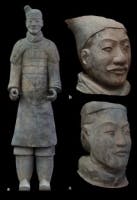Dating back to approximately 210 BC, China’s terracotta army is one of the country’s oldest and most famous relics. In an effort to determine if the soldiers were intended to represent an army of distinct individuals, or just generic soldiers, archaeologists from the University College of London (UCL) Institute of Archaeology employed 3D imaging and computer vision techniques to create models of the statues for analysis.
In order to solve the mystery of whether or not these soldiers actually represent individual warriors, the team used a structure-from-motion and multi-view stereo (SfM-MVS) approach to create color-realistic 3D models made from a series of overlapping digital images. The process began by capturing a number of images (camera type not named) of individual warriors and the warriors’ ears in order to provide initial input data to create the SfM-MVS models. After image acquisition, the SfM-MVS process begins by assessing each photograph to identify distinct groups of pixels that constitute features that are likely to be discernible in several images.
More Articles
(Slideshow) Six unique ways 3D imaging helped solve problems
Once the features have been described for each image, an algorithm is used to match them across multiple images to produce a network of spatial relationships from which individual camera position for each photograph can be reconstructed. The end result of this process is a sparse cloud of 3D point locations that mark the successfully-matched features. A much more dense set of 3D points can be created by grouping the image sequence into sub-sequences of images covering similar parts of the surface and then looking for more detailed matches over a coarse search grid, according to the academic paper.
The 3D point clouds the researchers generated contain the color information from the original image pixels. If necessary, a triangular mesh version can be created and detailed photographic texture can be applied per face instead of averaged color. The researchers plotted the 3D models against other models for analysis and found that of the 30 warriors they captured images of and fed through the computer algorithm, no two ears were identical, showing that the army likely consisted entirely of individual warriors. The team also plans to analyze other anatomical features to see whether the soldiers vary in ethnicity or specific trade or craft.
View the research paper.
Share your vision-related news by contacting James Carroll, Senior Web Editor, Vision Systems Design
To receive news like this in your inbox, click here.
Join our LinkedIn group | Like us on Facebook | Follow us on Twitter | Check us out on Google +






